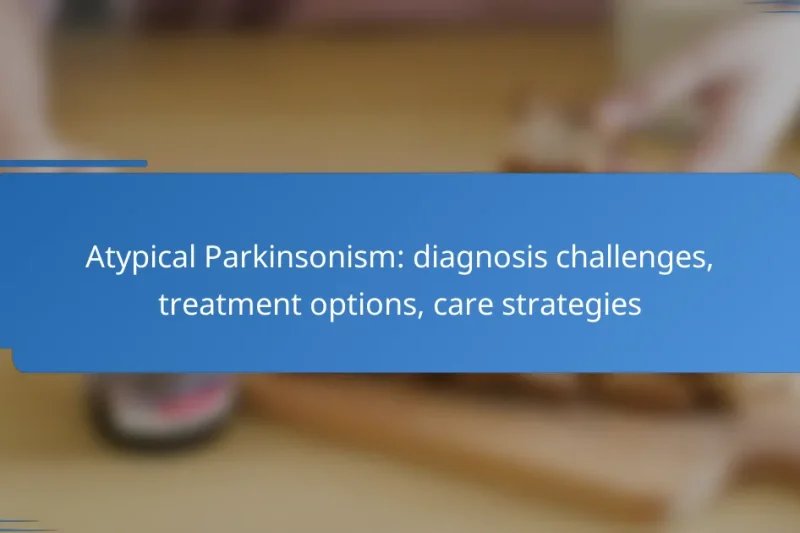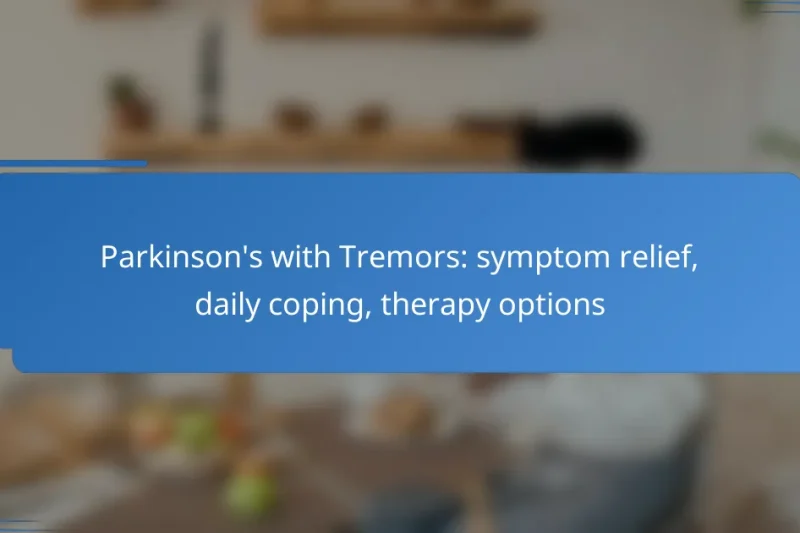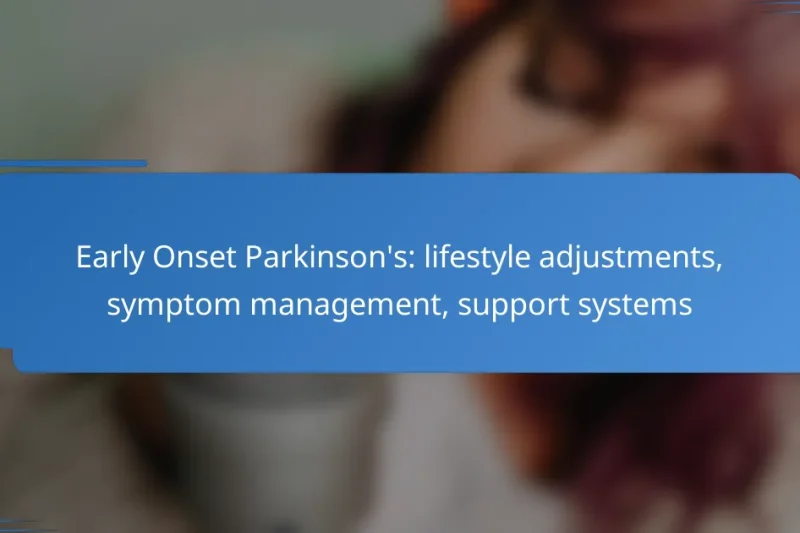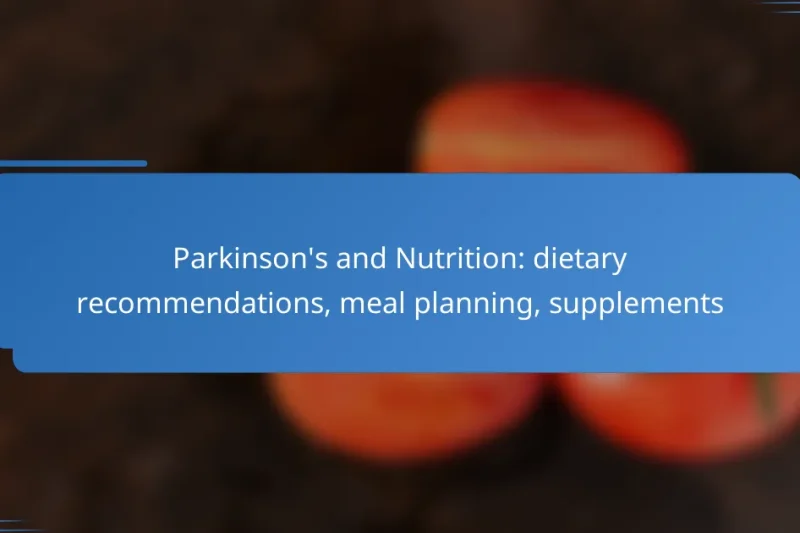Atypical Parkinsonism poses significant diagnostic challenges due to its symptom overlap with typical Parkinson’s disease and … Atypical Parkinsonism: diagnosis challenges, treatment options, care strategiesRead more
Living with Parkinson’s: Daily Management Techniques
Living with Parkinson’s requires effective daily management techniques to enhance quality of life and maintain independence. In New Zealand, strategies such as structured exercise, dietary adjustments, and proper medication management play a crucial role in managing symptoms and improving overall well-being. By incorporating these techniques, individuals can experience better mobility, reduced stiffness, and a more fulfilling daily life.
Parkinson’s and Caregiver Support: resources, coping strategies, communication tips
Caregivers of individuals with Parkinson’s disease play a crucial role in providing support and maintaining quality … Parkinson’s and Caregiver Support: resources, coping strategies, communication tipsRead more
Parkinson’s with Tremors: symptom relief, daily coping, therapy options
Parkinson’s disease can lead to challenging tremors that affect daily life, but there are effective strategies … Parkinson’s with Tremors: symptom relief, daily coping, therapy optionsRead more
Early Onset Parkinson’s: lifestyle adjustments, symptom management, support systems
Early onset Parkinson’s requires proactive lifestyle adjustments to enhance quality of life, including regular exercise, dietary … Early Onset Parkinson’s: lifestyle adjustments, symptom management, support systemsRead more
Parkinson’s and Nutrition: dietary recommendations, meal planning, supplements
For individuals with Parkinson’s disease, a balanced diet rich in essential nutrients is crucial for managing … Parkinson’s and Nutrition: dietary recommendations, meal planning, supplementsRead more
What daily management techniques can help with Parkinson’s in New Zealand?
Daily management techniques for Parkinson’s in New Zealand focus on improving quality of life and maintaining independence. These techniques include structured exercise, dietary changes, effective medication management, assistive technologies, and participation in support groups.
Exercise programs
Regular exercise is crucial for managing Parkinson’s symptoms. Programs may include activities like walking, swimming, or tai chi, which can enhance mobility and balance. Aim for at least 150 minutes of moderate exercise weekly, spread across several days.
Consider joining local classes or community programs tailored for individuals with Parkinson’s, as they provide both physical benefits and social interaction. Always consult with a healthcare provider before starting a new exercise regimen.
Dietary adjustments
A balanced diet can help manage Parkinson’s symptoms and overall health. Focus on a variety of fruits, vegetables, whole grains, and lean proteins. Some individuals may benefit from a diet rich in antioxidants, which can be found in foods like berries and leafy greens.
Stay hydrated and monitor protein intake, especially if you are on certain medications that may interact with dietary proteins. Consulting a nutritionist familiar with Parkinson’s can provide personalized guidance.
Medication management
Effective medication management is essential for controlling Parkinson’s symptoms. Work closely with a healthcare provider to establish a medication schedule that aligns with daily activities and minimizes side effects. Regularly review medications to ensure they remain effective.
Keep a medication diary to track dosages and times, which can help identify patterns or issues with symptom control. Be aware of potential interactions with over-the-counter medications and supplements.
Assistive technologies
Assistive technologies can significantly enhance daily living for those with Parkinson’s. Devices such as grab bars, mobility aids, and adapted utensils can improve safety and independence. Explore options available through local health services or rehabilitation centers.
Consider using smart home devices that can assist with daily tasks, such as voice-activated assistants for reminders or automated lighting systems. These technologies can help reduce the burden of daily management.
Support groups
Joining a support group can provide emotional and practical assistance for individuals with Parkinson’s and their families. These groups offer a platform to share experiences, coping strategies, and resources. Look for local or online support groups in New Zealand.
Participating in these groups can reduce feelings of isolation and provide valuable insights into managing daily challenges. Many organizations, like Parkinson’s New Zealand, offer resources and connections to local groups.
How can exercise improve daily life for Parkinson’s patients?
Exercise can significantly enhance the daily life of Parkinson’s patients by improving physical function and overall well-being. Engaging in regular physical activity can lead to better mobility, reduced stiffness, and improved mental health, all of which are crucial for managing Parkinson’s symptoms.
Enhances mobility
Regular exercise helps maintain and improve mobility in Parkinson’s patients by promoting flexibility and strength. Activities such as walking, swimming, or cycling can enhance coordination and balance, reducing the risk of falls. Aim for at least 150 minutes of moderate aerobic activity per week to see noticeable improvements.
Incorporating strength training exercises two to three times a week can further support mobility by building muscle mass, which often declines with age and disease progression.
Reduces stiffness
Exercise is effective in reducing stiffness commonly experienced by those with Parkinson’s. Stretching exercises, yoga, and tai chi can help improve range of motion and decrease muscle tension. Even short sessions of stretching throughout the day can provide relief and enhance comfort.
Consider integrating activities that promote gentle movement, such as dancing or low-impact aerobics, which can also help alleviate stiffness while being enjoyable.
Boosts mental health
Physical activity has a profound impact on mental health, particularly for individuals with Parkinson’s. Regular exercise can reduce symptoms of anxiety and depression, which are prevalent in this population. Engaging in group activities or classes can also foster social connections, further enhancing emotional well-being.
To maximize mental health benefits, aim for a mix of aerobic and strength training exercises, as both have been shown to improve mood and cognitive function. Consistency is key, so find activities that are enjoyable and sustainable.
What dietary changes are beneficial for managing Parkinson’s symptoms?
Dietary changes can significantly impact the management of Parkinson’s symptoms. Incorporating specific nutrients and maintaining hydration can help improve overall health and potentially alleviate some symptoms.
Increased antioxidants
Antioxidants play a crucial role in protecting brain cells from oxidative stress, which is linked to Parkinson’s disease. Foods rich in antioxidants include fruits like berries, vegetables such as spinach and kale, and nuts. Aim to include a variety of these foods in your daily diet to enhance your antioxidant intake.
Consider incorporating a colorful array of fruits and vegetables, as different colors often indicate different types of antioxidants. For instance, dark chocolate and green tea are also excellent sources that can be enjoyed in moderation.
Hydration importance
Staying well-hydrated is essential for everyone, but it becomes particularly important for individuals with Parkinson’s. Dehydration can exacerbate symptoms such as fatigue and constipation. Aim for at least 1.5 to 2 liters of fluids daily, adjusting based on activity level and climate.
Water is the best choice, but herbal teas and broths can also contribute to hydration. Be mindful of caffeine intake, as it can lead to dehydration if consumed in excess.
Balanced nutrition
A balanced diet is vital for managing Parkinson’s symptoms effectively. Focus on a mix of macronutrients: carbohydrates, proteins, and healthy fats. Incorporate whole grains, lean proteins like fish and poultry, and healthy fats from sources such as avocados and olive oil.
Consider meal timing as well; eating smaller, more frequent meals can help maintain energy levels throughout the day. Avoid heavy meals that may lead to sluggishness, and be cautious with protein intake if taking certain medications, as they can interfere with absorption.
How to effectively manage medications for Parkinson’s?
Effective management of medications for Parkinson’s involves adhering to prescribed regimens, tracking dosages, and maintaining open communication with healthcare providers. This ensures optimal symptom control and minimizes side effects.
Adherence strategies
Adherence to medication schedules is crucial for managing Parkinson’s symptoms. Setting reminders on phones or using pill organizers can help patients remember to take their medications on time. Establishing a routine, such as taking medications with meals, can also reinforce consistency.
Involving family members or caregivers in the medication process can provide additional support. They can help monitor adherence and assist in managing any side effects that may arise.
Tracking tools
Using tracking tools can enhance medication management for those with Parkinson’s. Apps designed for medication reminders can send alerts when it’s time to take a dose, while some allow users to log their symptoms and side effects. This data can be invaluable for adjusting treatment plans.
Alternatively, a simple medication diary can be effective. Patients can jot down when they take their medications and any changes in symptoms, providing a clear record for discussions with healthcare providers.
Consultation with healthcare providers
Regular consultations with healthcare providers are essential for effective medication management in Parkinson’s. These appointments allow for the evaluation of treatment efficacy and adjustments based on the patient’s experience. It’s important to discuss any side effects or concerns during these visits.
Patients should feel empowered to ask questions about their medications, including potential interactions and the importance of adherence. Keeping an updated list of all medications, including over-the-counter drugs, can facilitate these discussions and ensure comprehensive care.
What assistive technologies can aid daily living?
Assistive technologies can significantly enhance daily living for individuals with Parkinson’s by improving independence and safety. These tools range from smart home devices to mobility aids, each designed to address specific challenges faced in everyday activities.
Smart home devices
Smart home devices can streamline daily tasks and enhance safety for those living with Parkinson’s. For instance, voice-activated assistants can control lights, thermostats, and appliances, reducing the need for physical movement. Additionally, smart security systems can provide peace of mind by allowing remote monitoring of the home.
Consider integrating smart lighting that automatically adjusts based on time of day or motion sensors that illuminate paths during the night. These features can help prevent falls and create a more navigable environment.
Mobility aids
Mobility aids are essential for maintaining independence and safety when moving around. Common options include canes, walkers, and wheelchairs, each designed to support different levels of mobility. When selecting a mobility aid, consider factors such as weight, ease of use, and the specific needs of the individual.
For example, a rollator walker with a seat can provide support while allowing for rest breaks, making it suitable for longer outings. Always consult with a healthcare professional to determine the most appropriate aid based on mobility levels and daily activities.




